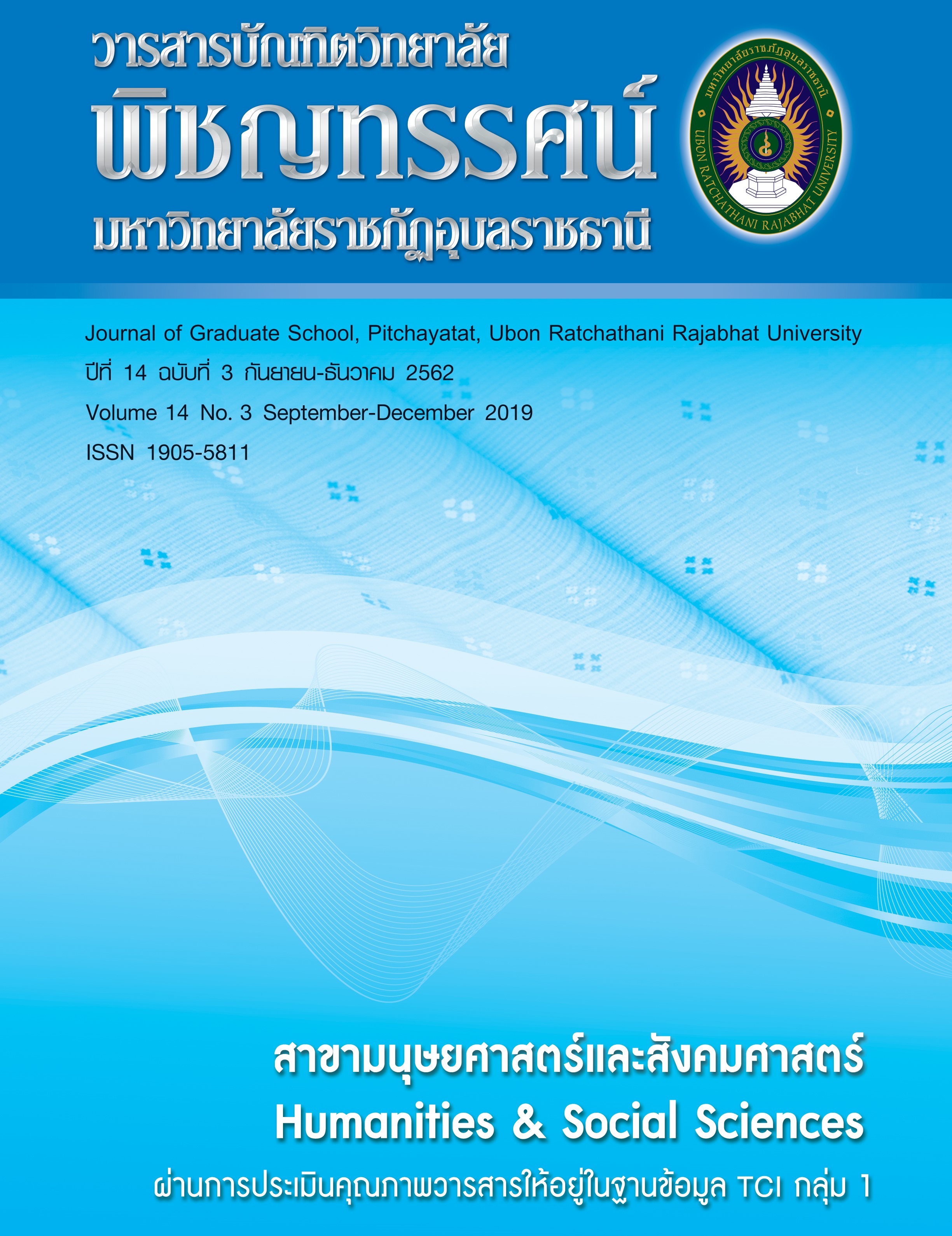แนวทางการเพิ่มประสิทธิภาพการบริหารทุนมนุษย์ของมหาวิทยาลัยราชภัฏสุราษฎร์ธานี
คำสำคัญ:
ประสิทธิภาพ, ทุนมนุษย์, การบริหารทุนมนุษย์บทคัดย่อ
การวิจัยนี้มีวัตถุประสงค์เพื่อ 1) ศึกษาระดับประสิทธิภาพการบริหารทุนมนุษย์ของมหาวิทยาลัยราชภัฏสุราษฎร์ธานี 2) เปรียบเทียบความคิดเห็นเกี่ยวกับประสิทธิภาพการบริหารทุนมนุษย์จำแนกตามสถานภาพส่วนบุคคลและ 3) นำเสนอแนวทางการเพิ่มประสิทธิภาพการบริหารทุนมนุษย์ของมหาวิทยาลัยราชภัฏสุราษฎร์ธานี เป็นการวิจัยแบบผสมซึ่งใช้แบบสอบถามและแบบสัมภาษณ์เชิงลึกเป็นเครื่องมือในการวิจัยกับตัวอย่าง ได้แก่ บุคลากรของมหาวิทยาลัยราชภัฏ สุราษฎร์ธานี จำนวน 300 คน และคณะกรรมการบริหารมหาวิทยาลัย จำนวน 11 คน สถิติที่ใช้ในการวิเคราะห์ข้อมูล คือ ความถี่ ร้อยละ ค่าเฉลี่ย ส่วนเบี่ยงเบนมาตรฐาน การทดสอบทีและการทดสอบเอฟ ผลการวิจัยพบว่า
- ประสิทธิภาพการบริหารทุนมนุษย์ของมหาวิทยาลัยราชภัฏ สุราษฎร์ธานี โดยรวมอยู่ในระดับปานกลาง (
= 3.47) เมื่อพิจารณารายด้าน พบว่า ด้านการปฏิบัติภาวะผู้นำอยู่ในระดับมาก (
=3.65) ด้านอื่นอยู่ในระดับปานกลาง เรียงจากมากไปน้อย ได้แก่ ด้านการสร้างประโยชน์สูงสุดจากกำลังคน (
= 3.48) ด้านความสามารถในการเรียนรู้ (
= 3.46) ด้านความผูกพันของบุคลากร (
= 3.37 และด้านการเข้าถึงความรู้ (
=3.36) ตามลำดับ
- การเปรียบเทียบความคิดเห็นจำแนกตามสถานภาพส่วนบุคคล พบว่า บุคลากรที่มีระดับการศึกษาสูงสุดและประเภทของบุคลากรแตกต่างกันมีความคิดเห็นแตกต่างกัน อย่างมีนัยสำคัญทางสถิติที่ระดับ 0.05
- แนวทางการเพิ่มประสิทธิภาพการบริหารทุนมนุษย์ของมหาวิทยาลัยราชภัฏสุราษฎร์ธานี ด้านการปฏิบัติภาวะผู้นำ ผู้บริหารต้องเป็นแบบอย่างที่ดีในการทำงาน บริหารตามหลักธรรมาภิบาล ด้านความผูกพันของบุคลากร ควรมีความชัดเจนถึงความเชื่อมโยงระหว่างผลการปฏิบัติงานและผลตอบแทนที่จะได้รับ ประเมินผลการปฏิบัติงานด้วยระบบคุณธรรม ด้านการเข้าถึงความรู้ ควรจัดกิจกรรมเสริมสร้างความรู้ทุกรูปแบบ เน้นการเป็นองค์กรแห่งการเรียนรู้ ด้านการสร้างประโยชน์สูงสุดจากกำลังคน ควรมีแผนอัตรากำลังที่ชัดเจนมีการจูงใจเพื่อดึงทุนมนุษย์ของบุคลากรมาใช้ ด้านความ สามารถในการเรียนรู้ ควรส่งเสริมให้บุคลากรได้รับการอบรมและพัฒนาตรงตามศักยภาพ มีการสอนงานและหมุนเวียนงาน
เอกสารอ้างอิง
คณะกรรมการพัฒนาเศรษฐกิจและสังคมแห่งชาติ, สำนักงาน. แผนพัฒนาเศรษฐกิจและสังคมแห่งชาติ ฉบับที่ 12 พ.ศ. 2560 – 2564 (ออนไลน์) 2559 (อ้างเมื่อ 12 มีนาคม 2560). จาก http: //www.ldd.go.th/www /files/7 8292.pdf.
พระพงษ์ชัย ชยวโส. การบริหารทรัพยากรมนุษย์ของ สำนักงานบริหารงานโครงการพระธรรมจาริกส่วนภูมิภาค. วิทยานิพนธ์พุทธศาสตรมหาบัณฑิต มหาวิทยาลัยมหาจุฬาลงกรณราชวิทยาลัย, 2556.
พิชญา วัฒนรังสรรค์. การเพิ่มประสิทธิภาพในการปฏิบัติงานของพนักงานโรงแรมระดับ 4 ดาว ภาคเหนือ. 2, 2 (มกราคม 2555): 93-102.
มณีวรรณ ฉัตรอุทัย. การศึกษาประสิทธิภาพการบริหารจัดการทุนมนุษย์ กรณีศึกษากลุ่มธุรกิจผู้ผลิตและจัดจำหน่ายพลังงานในประเทศไทย. วารสารบริหารธุรกิจนิด้า. 5 (พฤศจิกายน 2552): 5-19.
สิทธิชัย ศรีเจริญประมง. แนวทางการพัฒนา การดำเนินการด้านทุนมนุษย์เพื่อพัฒนาคุณภาพการ
บริการของสายการบินในประเทศไทย. วิทยานิพนธ์ศิลปศาสตรมหาบัณฑิต สถาบันบัณฑิตพัฒนบริหารศาสตร์, 2556.
อัญญพร จันทร์ประไพภัทร. การเปิดเผยข้อมูลทุนมนุษย์ ในประเทศไทย. การศึกษาอิสระบัญชีมหาบัณฑิต มหาวิทยาลัยธรรมศาสตร์, 2553.
ดาวน์โหลด
เผยแพร่แล้ว
รูปแบบการอ้างอิง
ฉบับ
ประเภทบทความ
สัญญาอนุญาต
บทความทุกเรื่องได้รับการตรวจความถูกต้องทางวิชาการโดยผู้ทรงคุณวุฒิภายนอกอย่างน้อย 2 คน ความคิดเห็นในวารสารบัณฑิตวิทยาลัย พิชญทรรศน์ มหาวิทยาลัยราชภัฏอุบลราชธานี เป็นความคิดเห็นของผู้เขียนมิใช่ความคิดเห็นของผู้จัดทำ จึงมิใช่ ความรับผิดชอบของบัณฑิตวิทยาลัย มหาวิทยาลัยราชภัฏอุบลราชธานี และบทความในวารสารบัณฑิตวิทยาลัย พิชญทรรศน์ มหาวิทยาลัยราชภัฏอุบลราชธานี สงวนสิทธิ์ตามกฎหมายไทย การจะนำไปเผยแพร่ต้องได้รับอนุญาตเป็นลายลักษณ์อักษรจากกองบรรณาธิการ






